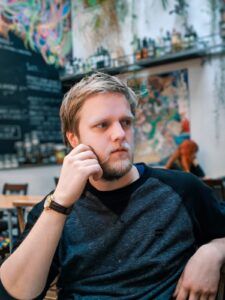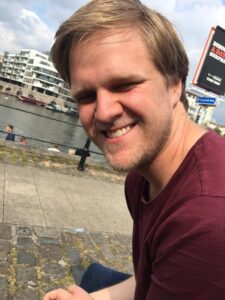
1) Please tell us something about yourself.
I am a (nearly) 30 year old guy from Bristol, England. Aside from being a writer, I’m a tutor for kids of all ages across a bunch of different subjects, which is a wonderful and fulfilling thing to do in between writing poems in the same three or four cafes. It wasn’t until I was at least 25 when I started writing – that is, aside from classwork and homework in school. But it has been exponential ever since.
2) You live in Bristol, England, so why do you want to join Writers in Kyoto?
I would like to come and spend time in Japan, and Kyoto is such a well of modern and historical/traditional culture that I often dream of being there. In researching writing communities and poetry journals in Japan, I discovered Writers in Kyoto, as well as the Kyoto Journal, and it was obviously such an interesting, valuable community made up of English-language writers that I felt compelled to inquire about joining. I’ve never been part of any writing community or group before, and so it is exciting to be joining this one!
3) You write tanka and haiku. Why did you choose those forms, and which do you prefer?
I have definitely fallen in love with the tanka form! That and the sonnet are my favourite – both words mean “short/little song”. Like most in the English-speaking world, I was taught that Japanese pottery was haiku, and that haiku were three lines, with the syllable pattern of 5-7-5. So I was majorly confused when I discovered haiku that, though they were three lines, were definitely not 5-7-5. I started to study Japanese poetry and got to know haiku, senryu, tanka, choka and others. I had always tended to write very long, verbose, flowery sentences, whether in prose or poetry. I still do. But Japanese poetry was such a different way of writing – in fact, the complete opposite – and I was drawn to it.

4) Your website is well-designed and original. Can you tell us how it was set up?
ありがとうございます! I had a free WordPress account originally, but I subscribed to their premium plan and played around with the templates and designs they had. I found a set-up that I liked the look of and which worked, and went with it. So really the compliment should go to WordPress… The images I use are sometimes my photos, but generally I find them online, and always put an image credit at the end with a link to where it’s from.
5) On your website you have a tanka about a Cafe Napolita in Japanese and English. Which language was it written in, and how do you find the task of translating yourself?
Well, it is a bit of a hybrid, in terms of which language it was composed in. The same goes for most of my poetry in Japanese so far. I have a tiny vocabulary, so I have to look words up and consult my little grammar book. However, I usually begin in Japanese, often trying out a new bit of grammar or set of words that I have recently learned, and adding in the words I have had to look up when needed – which is when it switches over to being half-composed in English. With all my Japanese poetry, the English translation is not what it would have been like had I just written it in English from the beginning. So I try to make the English somewhere between a translation and a literal, word-for-word accompaniment. It would be interesting to do the reverse, and to translate an English poem I have already written into Japanese…
6) What is your proudest achievement in writing so far?
The proudest feeling I have ever had with writing was in June 2019, in a cafe on the Bristol harbourside, when I wrote the words: Fire and starlight. With those three words, I finished The Floating Harbour, my first novel/novella. I started it in January of 2016, and so it had been with me for about three and a half years by the time I wrote the final words. It had begun out of my interest in the history of Bristol and its port, but it became a deeply personal journey, even as it kept that harbour history foundation and backdrop. I’ve written much poetry since, and am roughly halfway through another harbour novel/novella – all of which I am proud of. However, that moment still stands out. (The Floating Harbour is available as a free PDF on my WordPress.)
7) How would you like to see your writing develop in future?
Into fluent, creative Japanese! On the English side of things, I never really have a goal of any particular stylistic development, though I do have ideas for things I want to write. I do, however, recognise, in retrospect, stylistic developments. For example, I blame Ulysses by James Joyce for how weird my second harbour novel is becoming. I want to share my writing more and more widely, and to have it be always freely available, even if it makes it into purchasable, published form. I would like to lead poetry workshops with kids as well, in both languages and in both countries, and write with and alongside them. I just want to write, hand it to the world, then go and write some more.
William Altoft’s website can be accessed here.






Recent Comments